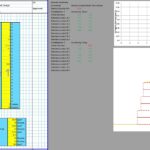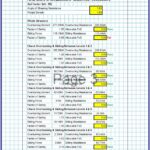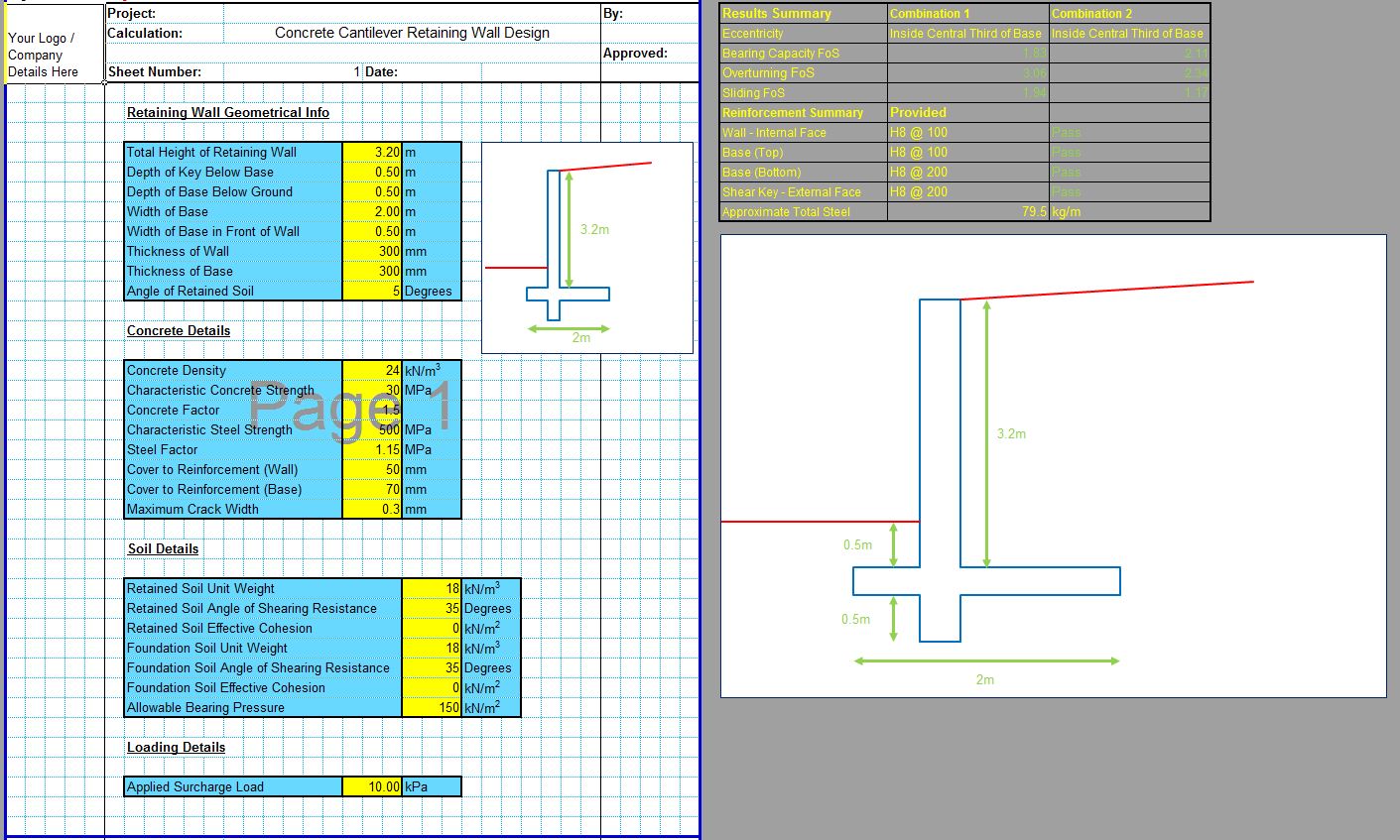The CivilWeb Stone Masonry Retaining Wall Design Spreadsheet is an advanced retaining wall design spreadsheet which completes the design of stone masonry retaining walls in accordance with BS EN 1997. The CivilWeb Stone Masonry Retaining Wall Design Spreadsheet comes complete with analysis tools which can be found nowhere else on the market. These tools allow the designer to complete a fully compliant and optimised stone masonry retaining wall design in minutes. The CivilWeb Stone Masonry Retaining Wall Design Spreadsheet can be purchased at the bottom of this page for only £20.
Alternatively the Stone Masonry Retaining Wall Design Spreadsheet is can be purchased along with all our other retaining wall design spreadsheets with the full CivilWeb Retaining Wall Design Calculations Excel Suite. This suite includes all 8 of our retaining wall design spreadsheets and can be purchased at the bottom of this page for a discounted price of £50, a saving of over 65%.
Stone Masonry Retaining Wall Design
The design of stone masonry retaining walls and any other modular retaining wall systems can be extremely time consuming. The design process is complicated by the fact that there are no bonds between the different levels of the retaining wall. This means that the stability calculations must be repeated for every different level of the retaining wall. For a high stone masonry retaining wall with many different levels, this can lead to dozens of separate stability calculations.
In order to complete a BS EN 1997 compliant design all these calculations must also be completed for two different partial action and material factors. BS EN 1997 requires calculations for Design Approach 1, Combination 1 and Combination 2. Completing these calculations once by hand will take several hours, and if the initial design is not acceptable or if the design needs to be optimised, these calculations may need to be completed several times.
The CivilWeb Stone Masonry Retaining Wall Design Spreadsheet completes these time consuming calculations instantly each time any design parameters are changed by the designer. The handy design summary table allows the designer to see at a glance exactly where the design is valid and where it needs to be increased. The designer can also see at a glance exactly where the stone masonry retaining wall is overdesigned, allowing optimisation to be completed in moments. unique graphs are also presented allowing the designer to see exactly what the optimal design values are for the key design parameters.
Using the CivilWeb Stone Masonry Retaining Wall Design Excel Sheet will save hours on every stone masonry retaining wall design. The quick and simple design process also allows much greater optimisation which saves money and time onsite.
Stone Masonry Retaining Wall Design - Inputs
The CivilWeb Stone Masonry Retaining Wall Design Excel Sheet calculates the stability of the stone masonry retaining wall against three failure modes as required by BS EN 1997. These three failure modes are overturning, sliding and bearing failure. The overturning and sliding failure modes must be checked for each level of the stone masonry retaining wall because there is no bond between levels preventing the modular units from sliding or overturning.
First the designer must input a proposed stone masonry retaining wall geometry. The main design parameters are the width and height of each level of the stone masonry retaining wall. In general the higher each course is the more stable the retaining wall will be. Usually there are standard heights for modular retaining wall units. The width is important to maintain the stability of the retaining wall and the width of the lowest course helps to spread the load and reduce the bearing pressure.
Finally the designer must choose whether the stone masonry retaining wall will have a sheer face or whether each course will be stepped. Stepped stone masonry retaining walls are more stable but there may be aesthetic or space reasons why sheer walls are desired. The overall height of the retaining wall is usually set by the site conditions.
An initial proposed stone masonry retaining wall design geometry can be taken from experience. The CivilWeb Stone Masonry Retaining Wall Design XLS Spreadsheet shows the designer exactly what geometry has been input. This allows the designer to quickly identify any errors. It also helps with the initial geometry, as usually a valid stone masonry wall geometry will look stable.
Next the designer must input the stone masonry wall design parameters such as density and the friction between levels. This information can be taken from the manufacturer of the modular units or from typical values. The density of the stone masonry is important in maintaining stability, though a denser heavier stone masonry will exert a higher bearing pressure on the underlying ground.
For the final step of the design the designer must input the soil design parameters including oil density, angle of internal friction and allowable bearing capacity. The CivilWeb Stone Masonry Retaining Wall Design XLS Spreadsheet checks the retaining wall against bearing failure by calculating the bearing pressure and using the allowable bearing capacity of the underlying soils. The allowable bearing capacity of the underlying soils can be taken from presumed values though this should be checked with onsite testing before the final design is completed. A detailed bearing capacity analysis can be undertaken using software such as the CivilWeb Soil Bearing Capacity Spreadsheet.
Generally the allowable bearing capacity will limit the maximum settlement of the foundation to less than 25mm which is generally fine for stone masonry retaining walls. However, in some conditions the settlement of the foundation could also be significant. This can occur in some clay or organic soils where significant consolidation settlement can occur over many years after the wall is built. In these cases a separate settlement analysis can be undertaken using software such as the CivilWeb Foundation Settlement Calculation Spreadsheet.
Stone Masonry Retaining Wall Design - Stability Calculations
Finally the CivilWeb Stone Masonry Retaining Wall Design Spreadsheet completes the stability calculations for the full structure and for each layer. The spreadsheet then presents these results in a handy summary table. The calculations are completed automatically and presented to the designer along with the inputs. This makes it simple for the designer to tweak any of the design inputs and see instantly the effect on the stone masonry retaining wall stability. It also allows the designer to see at a glance where the retaining wall design can be optimised, by reducing the width of certain layers for example.
The CivilWeb Stone Masonry Retaining Wall Design XLS Spreadsheet completes these calculations in accordance with BS EN 1997 which requires two different sets of partial action and material factors. These are Design Approach 1, Combinations 1 and 2. The partial factors are preset in the spreadsheet in accordance with BS EN 1997 but these can be altered by the designer if required.
CivilWeb Stone Masonry Retaining Wall Design Spreadsheet
The CivilWeb Stone Masonry Retaining Wall Design Spreadsheet includes unique design and analysis tools. This allows the designer to complete a fully compliant and fully optimised stone masonry retaining wall design in minutes, saving hours of design work on every design.
Buy now for only £20.
Buy the Stone Masonry Retaining Wall Design Spreadsheet together with the Gabion Wall Design Spreadsheet at a discount of over 35%.
Or buy our best value bundle, the full Retaining Wall Design Suite including all 8 of our design spreadsheets at a discount of 65%.
Download Free Trial Version
To try out a fully functional free trail version of this software, please enter your email address below to sign up to our newsletter.
Other Retaining Wall Design Spreadsheets;
Retaining Wall Design Calculations Excel Suite
Our full Retaining Wall Design Suite includes all 8 of our retaining wall design spreadsheets for only £50.











